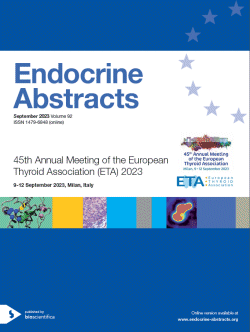
45th Annual Meeting of the European Thyroid Association (ETA) 2023
45th Annual Meeting of the European Thyroid Association ETA 2023
Oral Session 9: Thyroid Eye Disease
ea0092op-09-01 | Oral Session 9: Thyroid Eye Disease | ETA2023
VRDN-001, a full antagonist antibody to IGF-1 receptor: in vitro pharmacology and phase 1/2 results in patients with thyroid eye disease (TED)
Douglas Raymond , Ugradar Shoaib , Turbin Roger , Cockerham Kimberly , Tang Rosa , Nijhawan Navdeep , Kossler Andrea , Boisvert Chantal , Lee Wendy , Yen Michael , Kaufman David , Yoon Michael , Bedian Vahe , Katz Barrett
ea0092op-09-02 | Oral Session 9: Thyroid Eye Disease | ETA2023
Preclinical pharmacokinetics and clinical exposure prediction for VRDN-003, a next-generation half-life extended antibody to the IGF-1 receptor for thyroid eye disease
Foster Kelly , Dickinson Brent , Bedian Vahe
ea0092op-09-03 | Oral Session 9: Thyroid Eye Disease | ETA2023
Linsitinib, AN IGF-1R inhibitor, attenuates disease development and progression in a model of thyroid eye disease
Gulbins Anne , Horstmann Mareike , Daser Anke , Flogel Ulrich , Oeverhaus Michael , Bechrakis Nikolaos , Paul Banga J , Keitsch Simone , Wilker Barbara , Krause Gerd , Hammer Gary , Spencer Andy , Zeidan Ryan , Eckstein Anja , Philipp Svenja , Gortz Gina-Eva
ea0092op-09-04 | Oral Session 9: Thyroid Eye Disease | ETA2023
Novel, rapid, sensitive bioassay for thyrotropin receptor stimulatory antibodies- a multicenter, single blind study
Kahaly George , Bossowski Artur , Frommer Lara , Hatun Burak , Wolf Jan , Lupo Mark
ea0092op-09-05 | Oral Session 9: Thyroid Eye Disease | ETA2023
Clinical and visual outcomes of dysthyroid optic neuropathy after surgical orbital decompression
Armenti Mirco , Curro Nicola , Guastella Claudio , Bottari De Castello Alessandra , Chiara Fazio Maria , Contarino Andrea , Rossi Giada , Muller Ilaria , Arosio Maura , Viola Francesco , Pignataro Lorenzo , Salvi Mario



